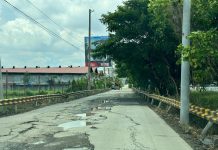The future of the mangroves in the Philippines and other members of the Southeast Asian Nations (ASEAN) looms uncertain, according to scientists from the University of the Philippines – Diliman College of Science (UPD-CS).
The forecast was based on a comprehensive survey of over 300 mangrove studies across the Philippines and the rest of Southeast Asia. It has “found large gaps in our understanding of the current and future state of these already dwindling natural resources,” deplored Maria Gerona-Daga and Professor Dr. Severino Salmo III.
Gerona-Daga is a biology student currently pursuing her Ph.D. at UP while Dr. Salmo is a biology associate professor at the same university.
The UP scientists singled out the Philippines as the second worst country in ASEAN in terms of mangrove losses. It suffered a 10.5% decline between 1990 and 2010, based on independent studies included in the survey. The country is surpassed only by Myanmar (Burma), which suffered a 27.6% loss between 2000 and 2014.
The years 2021 to 2030 have been declared as the United Nations Decade on Ecosystem Restoration, which aimed at preventing, stopping, and reversing the degradation of ecosystems around the world.
The findings of the new study are a stark wake-up call. “With the countdown well underway, the comprehensive survey undertaken by of existing mangrove restoration research helps identify ways to achieve the SEA region’s restoration targets and safeguard their biodiversity,” said a statement obtained by this author.
The study, entitled “A systematic review of mangrove restoration studies in Southeast Asia: Challenges and opportunities for the United Nation’s Decade on Ecosystem Restoration,” is said to be the first of its kind in Southeast Asia.
The pioneering study provides a systematic and quantitative synthesis of 335 mangrove restoration studies in the region that were published before February 2022. In addition, the investigation has likewise identified regional successes and failures in mangrove restorations.

The researchers underscored the increasing need for mangroves’ adaptability to climate change. “This, in turn, creates the need for new technologies and innovations that can fast-track the sustainable recolonization of mangroves,” they said.
The study suggests potential government policies to support continued research and community involvement in mangrove monitoring.
“Southeast Asian collaborations are essential in sustaining regional mangrove protection: establishing and strengthening partnerships with neighboring countries will enable the region to form unified goals and facilitate more sustainable restoration measures,” the two UP researchers said. “Sharing knowledge and other resources in the SEA region can also benefit countries with limited mangrove restoration research.”
To this end, Gerona-Daga and Salmo proposed an ASEAN journal focused on mangrove restoration, conservation, and management composed of a multinational scientific editorial board to share mangrove research to a wider platform efficiently and ultimately contribute to effective restoration practices.
“Our study aims to provide suggestions in line with international commitments of ASEAN-member countries,” Prof. Salmo said. “The pressing need is to establish and consistently monitor the state of the mangroves for each country, protect mangroves through biodiversity conservation programs, and more importantly, to stop or limit coastal reclamation projects.”
Mangroves grow well in tropical countries, including the Philippines. “Mangroves are an important part of the coastal and marine ecosystem that includes the seagrasses and the coral reefs,” states the Department of Environment and Natural Resources (DENR).
Mangroves are communities of trees in the tidal flats in coastal waters, extending inland along rivers where the water is tidal, saline, or brackish. “There are 25 to 30 species of true mangrove trees and an equal number of associated species,” says Dr. Miguel Fortes, one of the country’s foremost experts on coastal ecosystems.
Dr. Theresa Mundita Lim, when she was still the director of the Biodiversity Management Bureau, said BMB has identified 42 species of mangroves in the country. None of them are facing extinction yet. But the International Union for Conservation of Nature (IUCN) is considering putting 11 out of 70 mangrove species assessed on the IUCN Red List of Threatened Species.
Mangroves are very important to marine life, says Dr. Rafael D. Guerrero III, an academician of the National Academy of Science and Technology (NAST). They serve as sanctuaries and feeding grounds for fish that nibble on detritus (fallen and decaying leaves) trapped in the vegetation, and on the bark and leaves of living trees.

“(Mangroves) are important feeding sites for many commercially important fish species (mullet, tilapia, eel, and especially milkfish), shrimps, prawns, mollusks, crabs, and sea cucumbers,” a World Bank report on environment adds. “Fry that gather in mangrove areas are very important for aquaculture.”
Unknowingly, mangroves also help protect people and even properties from destruction brought about by typhoons. Moises Neil V. Seriño, assistant professor of the Department of Economics at the Visayas State University, found this out after he and co-researchers conducted a study on the aftermath of Super Typhoon Yolanda in 2013.
“Our study shows that mangrove vegetation reduced the number of deaths and damaged houses during the Yolanda incident,” Seriño said. “This property and lifesaving effects of mangrove is robust. Mangroves can protect us (our lives, livelihood and properties) from damaging effects of typhoons.”
Gerona-Daga and Salmo believed the UN Decade on Ecosystem Restoration is a perfect opportunity to underscore the urgency of mangrove restoration. Mangroves provide a long list of ecological and socio-economic benefits, so much so that the International Union for Conservation of Nature (IUCN) refers to them as “nature’s superheroes” because they not only provide livelihood and habitats to animals but also mitigate climate change and reduce the impacts of storms and other natural disasters.







